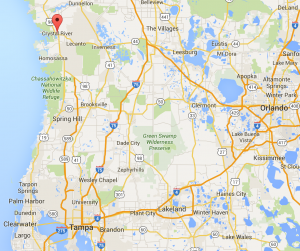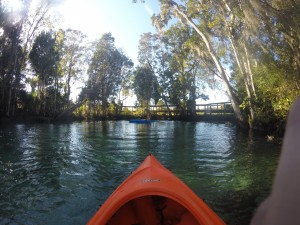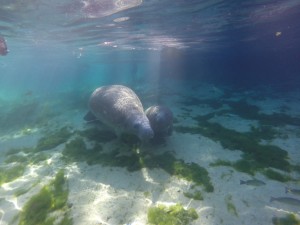Posted November 7, 2015
By MARWAN ALENEZI
CRYSTAL RIVER, Fla. — “Right there! Kid in the blue trunks, don’t move!” screamed a park ranger from his kayak. “Let him come to you!”
It took a few seconds to realize what he was telling me. For animals of their size and weight, manatees really move with unnoticeable grace.
A baby manatee was edging closer to me from the riverbed, attempting to nibble on my foot.
It took a moment, but the calf realized that my feet don’t look or taste like sea grass. Within 15 seconds, the fat mammal that is the pride of this Florida town swam right back to mommy, leaving only jealous tourists telling me how lucky I just was.
Crystal River is a small city town in Citrus County, Fla. It’s approximately a four and a half hour drive northwest of Miami and its purity and serenity are revealed everywhere, from its people to its natural beauty. It’s a small community with approximately 3,000 people and probably has just as many lakes, streams and marshes.
 Ecologically it’s the most “Floridian” city in the state.
Ecologically it’s the most “Floridian” city in the state.
Simply driving up there can only be remembered in terms of the color green in rapid motion.
Citrus County and surrounding areas have many wildlife preserves, sanctuaries, parks and trails.
Environmentally, it is an incredibly well protected and locally respected place. The most respected of all has to be the body of water it was named after: Crystal River.
The river lives up to its name to say the least. It has a number of breathtaking estuaries where the water’s clarity tends to confuse a person’s perception of its depth. Luckily for visitors they are very shallow, because its makes it easier for people to witness a remarkable natural phenomenon found only in a handful of small places around the planet: a manatee migration.
Crystal River has the healthiest population of manatees in North America. At any time during the year, visitors are almost guaranteed to see at least one of these very large and docile marine mammals. During the winter months, hundreds of manatees begin to migrate to this freshwater destination from as far north as the Carolinas.
The water temperature is a constant, year round, at 72 degrees Fahrenheit, which is perfect for them (but the very threshold of tolerable for my Saudi Arabian friend and I!). It’s one of nature’s wonders as well as Florida’s natural highlights, which is saying something because since it is the most bio diverse state in the nation.
The river is a famous snorkeling and scuba diving destination, arguably on the international level. It is a scuba hub because of its underwater caves and cavern systems, and is a snorkeling dream because of its manatees.
After checking in to a motel that was the closest to the water (easy access is key, of course), I set out to find the manatees. The migration was to slowly begin in the beginning of November to February. The destination: Three Sisters Springs.
Locally referred to as “the springs,” the Three Sisters is a small, closed bay with arguably the clearest water in the state. More importantly, this is where manatees decide to gather around when nature’s vacation drives them down to Florida.
Three Sisters and neighboring springs can be reached in a few ways: boat, kayak, paddleboard, or through a recently built park boardwalk to view animals from shore. For photography reasons, we decided to take a kayak for a brief 15-minute ride.
The atmosphere was pure wilderness. Ospreys, the most aquatic of raptors, were swooping down and grabbing fish from the water’s surface. Pelicans waded in the water until we got too close, flapping their large wings and showing their impressive span. But the blistering heat of late October, contrasted with significantly colder and tempting waters, only drove us quicker to our destination.
After swimming around docks and piers, we reach an area full of protected springs. Large signs where everywhere, warning us of the impending doom awaiting those who litter, or the serious infraction of speeding in one of many manatee zones.
But the signs weren’t what hinted to us that the area as protected. Slowly, but surely, the murky brown waters of the docks and piers gradually began to turn into clear, clean water. A few more strokes and we could see the bottom, which is when we kayaked between a few poles (built to hinder boats from entering) and officially reached the springs.

A few seconds after paddling out of the river and into the springs, the water turns clear, reflecting the surrounding flora.
It really does not take any knowledge or experience to realize why the area is known for its diving and snorkeling.
Aziz Alhowiash, a business major at UM in his senior year and avid kayaker during the weekends, said he was astounded.
“I don’t know anything about marine biology, but its easy to see why (manatees) want to be here. It’s heaven! Do you think we can drink this water, Marwan?” he wondered.
I had trouble paying attention. A few Australian paddlers were yelling and pointing at the water. With a camera in one hand and a paddle in the other, I decided to get off the kayak, which I found out is hard to do without flipping.
To prevent erosion, it is forbidden to tie kayaks and paddleboards to any vegetation. Luckily, the springs are somewhat closed off and have zero waves or detectable current, so it was easy to just leave the kayak on the side and it does not move.
With a dip into the chilly water, it took less than a minute to spot three massive, fat manatees. One of them was so large, it even caught the ranger’s eye. John, a manatee safety volunteer on a bright yellow kayak and equally bright yellow vest, said that that one must weigh at least a ton.
“You can tell just by looking at him?” asked an elderly Australian paddler. “The water is that clear today, sir!”
In the middle of his friendly discussion, John stopped to tell a young woman not to swim directly to another manatee. That one happened to be a mother with her calf.
“Remember, you can’t go up and touch them, but they can come and touch you. It’s the difference between breaking the law and having a great vacation!” he said.
Swimming in perfect water and being surrounded by a rare species was beautiful enough, but then John told me to stay still as that same mother and calf swam to me and gave me a few minutes of relaxed photography opportunity.
Later, at a local restaurant and bar, our server, Amy Creel, wasn’t as impressed to hear this story, which is saying something since she may be the friendliest person I have encountered.
“We used to think they’re cute, too! But, in the winter, it’s just annoying, they’re everywhere! They cause hours of boat traffic! My husband was going a smidge faster than the speed limit when he got slapped with a felony! A felony! All for a fat animal they call a sea cow,” Creel told us.
Luckily for him, the charge was dropped, but it just goes to show how valuable these animals, and the surrounding environment, is to this city and state. Still in awe at the serenity of the place, we packed our gear the next morning, ready to hit the road.
As I stopped for final look at the water, two dolphins surfaced a few feet outside our hotel room door. Many parts of Florida, lesser known to the general public, remain as wild as this site is. Hopefully everyone can realize this is the state’s true face of fun.
If You Go
Where to stay: King’s Bay Lodge, 506 NW 1st Ave., Crystal River, Fla. 33428, or nearby hotels.
Renting gear: Crystal River Watersports, 2380 N. Suncoast Blvd., Crystal River, Fla. 34428

